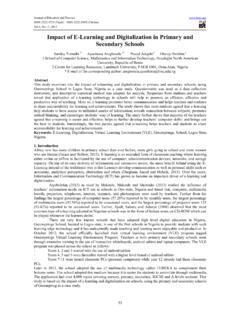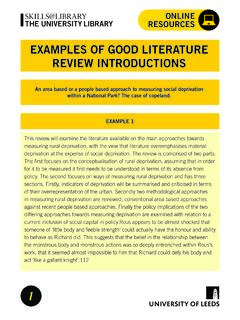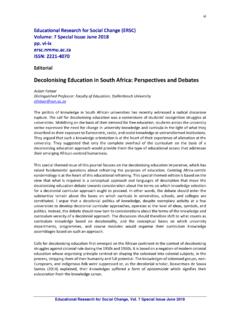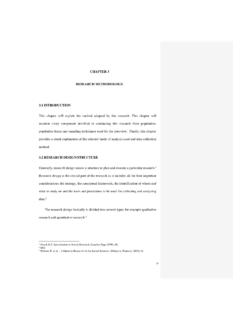Transcription of ˘ˇ ˆ - NCGS
1 Advances in Gender and Education, 1 (2009), 11-13. Printed in the USA. 2009 Montgomery Center for Research in Child & Adolescent Development This essay will provide a brief historical overview of the educational experiences of girls and women in the United States dating from the early colonial settlement years to the present time. From dame schools in the 1700s to seminaries for teacher training, women and girls have historically been prepared for professions related to caretaking, such as nursing and teaching. A dramatic shift occurred in the 1970s with the passage of Title IX of the Education Amendments Act of 1972, which protects students from discrimination on the basis of sex in educational programs that receive federal financial assistance, and the Women's Educational Equity Act (WEEA), enacted in 1974.
2 In spite of the new policies, many of the educational patterns of girls continued. Sev- eral researchers in the 1980s and 1990s suggested that female students in coeducational classrooms received less opportunity to participate and less feedback from teachers than their male counterparts (Grossman, 1998;. Riordan, 1990; Sadker & Sadker, 1995). With the passage of No Child Left Behind in 2002 and the resulting changes in federal regulations (final rule changes published in 2006), prior restrictions on the establishment of single sex public schools and classrooms were lifted. Initial research on single sex programs indicate promise of academic achievement for girls and demonstrate socio-emotional benefits for girls attending single sex schools in urban, high poverty areas (United States Department of Education, 2008; author, 2008).
3 Current advocates of single-sex education believe that it should be available as an option for all students, not just for children of privilege. Single-gender education is not a new concept. At the close of the 18th century, most boys in colonial America attended dame schools, defined as a school influenced by the English model of home instruction for small groups of children usually led by a woman in her home (Monaghan, 1988). These schools in New Eng- land prepared boys for town schools (Monaghan, 1988). Girls also attended dame schools, but only a small percentage attended town schools or academies. Educational institutions beyond the dame schools and single gender town schools were private, segregated by sex, and exclusive to wealthy families (Riordan, 1990).
4 The establishment of dame schools took place in the kitchens of older women in the community. It was at this juncture that women established themselves as teachers in colonial America. The primary focus of the dame schools was to prepare boys for admission to the town schools which, until the 19th century, girls were not allowed to attend (Riordan, 1990). When girls were finally admitted to the town schools, they usually attended at different times of the day than the boys or on days when boys did not attend, such as summertime or holi- days. The Massachusetts educational system has its roots in the Protestant Reformation which considered edu- cation necessary for all individuals to understand Scripture.
5 Within 10 to 20 years of the arrival of the May- flower, Massachusetts colonists had established town schools, a Latin grammar school, and Harvard College (Kolesnick, 1969). The growing economy in the colonies created an additional need for literacy. Colonial women were often heavily involved in family businesses and commerce. These conditions provided some of the foundation for equal opportunities for men and women in the educational process (Riordan, 1990). ! " # $ %&'%( ) * + ,-. %(, //'/. 0" 1 ! '(. Concurrent with the establishment and growth of the coeducational public high school system in the 1800s was the single-gender seminary or academy movement.))
6 Led by Catherine Beecher, Emma Willard, and Mary Lyon, these institutions were modeled after the English finishing school. The function of the academy was to provide a moral, literary, and domestic education for young women (Riordan, 1990; Sexton, 1976). The Catholic Church played an important role in the burgeoning academy movement. By 1860, the Catholic popu- lation had increased to 3 million creating a great need for church-sponsored education. Seminaries served as a preparation ground for female teachers who were in growing demand to serve as educators in Catholic girls'. schools (Riordan, 1990). The seminaries took on the training of teachers in an innovative manner, promoting dynamic teaching strategies and student cooperation (Sadker & Sadker, 1995).
7 Eventually, the academy move- ment would lead to the establishment of the first women's colleges in the United States including Georgia female College, Mount Holyoke Seminary, and Elmira female College (Astin & Hirsch, 1978). The limited population in the western territories in the early and mid-1800's made coeducation an eco- nomical and more viable option to single-gender institutions. This was not the case in the eastern states, how- ever, where the established bastions of higher education remained financially independent. As a result, counter- parts to the distinguished male colleges emerged in the form of affiliates. Affiliations with universities such as Harvard, Columbia, and Brown allowed women to participate, in a limited fashion, in the educational opportu- nities afforded to men in these prestigious institutions (Riordan, 1990; Stock, 1978).
8 In college, women were closely supervised and segregated from men. Toward the end of the 19th century, some state universities allowed women to enroll in their degree programs. The private institutions, however, did not follow this pattern. As a result, Smith, Mount Holyoke, Wellesley, Barnard, Radcliffe, Vassar, and Bryn Mawr were established to provide women with single-gender university environments designed to meet their specific educational needs. Despite the emergence of single-gender colleges for women, by the beginning of the 20th century, most public secondary schools and colleges had become predominantly coeducational. Coeducation, however, did not insure equal opportunity in education.
9 In 1918, the Commission on the Reorganization of Secondary Edu- cation made a case for the creation of a two track system: one track steered students, primarily males, toward college preparatory coursework, and the other track provided vocational training. For White, Black, and other minority girls, the vocational track was encouraged. Even girls with strong academic records were required to take domestic science or home economics (Tyack & Hansot, 1990). Despite the expansion of women's role in society, through the mid 1960s girls were channeled into occupational choices that were limited to four catego- ries: secretarial, nursing, teaching, or motherhood (Sadker & Sadker, 1995).
10 In 1972, with the passage of Title IX, it became illegal to discriminate in public schools on the basis of sex in school athletics, financial aid, career counseling, admission practices, and the treatment of students. Violators were at risk of losing federal funds. With the passage of the Women's Educational Equity Act (WEEA) in 1974, support was provided to assist schools in the recruitment of girls for math, science, and athletic programs. Teachers were provided with training to increase awareness of gender bias in curriculum and pedagogy. In the 1980s, however, funding for WEEA was drastically cut. ! ". In 2006, the United States Department of Education published amendments to the Title IX regulations that provide school districts with flexibility in the implementation of single-sex programs.









